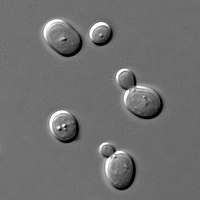
Photo from wikipedia
Sugarcane syrup is defined as the product obtained by the concentration of sugarcane juice (Saccharum officinarum L.) or from melted cane rapadure. This product has good acceptance in the Brazilian… Click to show full abstract
Sugarcane syrup is defined as the product obtained by the concentration of sugarcane juice (Saccharum officinarum L.) or from melted cane rapadure. This product has good acceptance in the Brazilian market and can be used as a sweetener in substitution of refined sugar, besides containing important minerals. This study analyzed samples of sugarcane syrup based on its microbiological and microscopic properties. In total, 15 commercial brands of sugarcane syrups were analyzed. No brands had the presence of flat-sour thermophilic bacteria, total coliforms or Escherichia coli, while five brands were contaminated with mesophilic bacteria, molds, and yeasts. Microscopic analysis, performed under optical light transmission microscopy, revealed that 14 (93%) brands contained some kind of dirt or foreign material, with only one brand (M) according to the standards. The Brazilian standard in force (RDC, 2001) specifies the microbiological standards for food but does not contain important information for sugarcane syrup, and an update is required.
Journal Title: Journal of Agricultural Science
Year Published: 2019
Link to full text (if available)
Share on Social Media: Sign Up to like & get
recommendations!